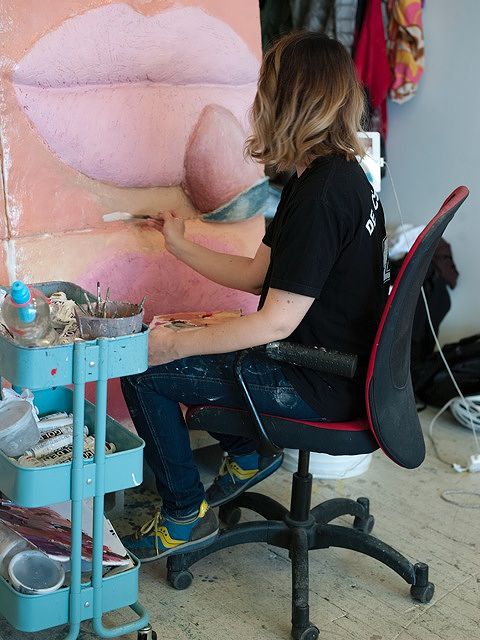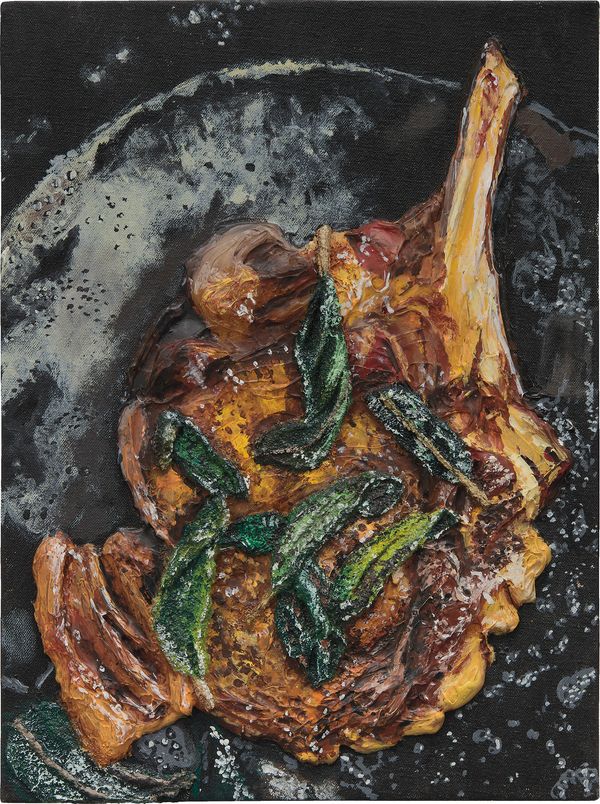Artist Gina Beavers. Photography courtesy of Aubrey Mayer and Marianne Boesky Gallery.
Born in Athens, Greece, Gina Beavers paints sculptural works that explore the digital landscapes of our everyday lives. Drawing on images taken from Instagram, YouTube, image databases and other online sources, she creates thick, tactile paintings that capture the curated and often superficial nature of our digital lives. In March 2019, MoMA PS1 opened Beavers' first solo museum exhibition, Gina Beavers: The Life I Deserve, which is accompanied by the artist's first monograph. Her work has also been included in group presentations at Kentucky Museum of Contemporary Art, Louisville; Nassau County Museum of Art, New York; and the Flag Art Foundation, New York, among others. The artist's first show with Marianne Boesky Gallery will open in Spring 2020.
Ahead of our New Now auction in New York on 24 September, in which Beavers' Pork Chop and Basil, 2012, will be on offer, we caught up with the artist and got a tour of her studio.
PHILLIPS: How long have you been making art?
GINA BEAVERS: My mom is an artist and an art teacher, and always had a studio in our home. She did a lot of art projects with me when I was young and took me to museums constantly. I struggled for a long time to define myself as separate from her and rejected art a bit as a teenager, getting into theater and going to college for pre‐med! But I took my first official art class in college when I was failing out of pre‐med because my mom said, "Hey, you should take an Art class!"
Gina Beavers in her Newark studio. Photography courtesy of Aubrey Mayer.
P: How and when did you begin to find your sculptural, three‐dimensional style of applying paint?
GB: I was in a studio building in Bushwick about ten years ago and Art Guerra, who owned the paint company Guerra in the East Village, was down the hall. They make very high-quality acrylics with tons of innovative applications. We became friends and he would bring me things to experiment with, and I started playing around with his acrylic and thickener. I had been making really flat, graphic paintings previously, but I had started to feel like I might as well make those efforts on a screen printer, and I wanted to find a way to make paintings that couldn't be so easily made by a machine. I also enjoyed the challenge of building and cutting away the paint in order to get to a realistic image. The bulkiness of the acrylic really ran interference and gave me something to battle on the way to creating something recognizable.
P: You find a lot of your source imagery online. As we're all so constantly bombarded with pictures, what stops you in your tracks?
GB: That's a great question. It's really difficult to define but, generally, I'm arrested by images that have interesting formal qualities, color, composition but also a compelling narrative. I really like when an image is saying something that leaves me unsure of how it will translate to painting, like whether the meaning will change in the context of the history of painting.
Gina Beavers in her Newark studio. Photography courtesy of Aubrey Mayer.
P: How time‐consuming and physical is your process?
GB: Very time‐consuming and can be physically grueling as well! Because of the nature of the acrylic and the thickness, I have to start a series of paintings all at once so that they have enough time to dry. I go back and forth working on them over time. I wear a mask and, for the large ones, I have to actually sit or lie on the piece when I'm making them because they have to lie flat until they are almost done. I recently switched to a heavier acrylic and realized I was getting numbness in my left hand from holding my acrylic cup—my doctor thinks I have carpal tunnel from making them, so they’re definitely physically demanding!
I feel like my understanding of what art can be is made up of moments experiencing artworks that I immediately "got" and kind of instantly metabolized.
P: 'The Life I Deserve' was your first solo show in a museum. What was this moment like for you, and what was your reaction to being exhibited among such a diverse group of artists this summer at MoMA PS1—from Nancy Spero and Simone Fattal to Titus Kaphar and Zheng Guogu?
GB: Ah, it was a dream. It was one of those moments where you feel acknowledged and supported, and like this crazy life and obsession you have is important to others too! It was truly an honor to show alongside the other artists at PS1, an amazingly brilliant, global group. The curator of my show, Oliver Shultz, did such an amazing job championing, organizing and interpreting my work. PS1 is a really special institution, it has nurtured me through the years of shows and programming I have experienced there, and it felt like a perfect place for my paintings to be seen.
Gina Beavers, Pork Chop and Basil, 2012. Coming to auction in Phillips' New Now sale on 24 September 2019.
P: Some may make associations between your work and that of Claes Oldenberg and Coosje van Bruggen. Who are the artists from the past who most actively influence your work?
GB: It's interesting because I feel like my understanding of what art can be is made up of moments experiencing artworks that I immediately "got" and kind of instantly metabolized. Works by Oldenburg/Van Bruggen, Paul Thek, Jack Whitten, Lee Bontecou, Alice Neel, and then a certain wildness and love of experimentation I absorbed from underground women's comics from artists like Aline Kominsky Crumb or Julie Doucet.
P: You recently left Brooklyn and decamped for Newark. What impact has this made so far?
GB: Honestly, I’m super focused out here. Things are a little more relaxed, I have more space and I feel like I have a more direct line with my work, because the larger‐than‐life intensity of New York isn't intruding as much! I will always love New York (I'm there at least once a week), but this felt like a good time to admit to myself how most of my time is spent at the studio and to try arranging my life a little differently. AND I'm ten minutes from the airport!



